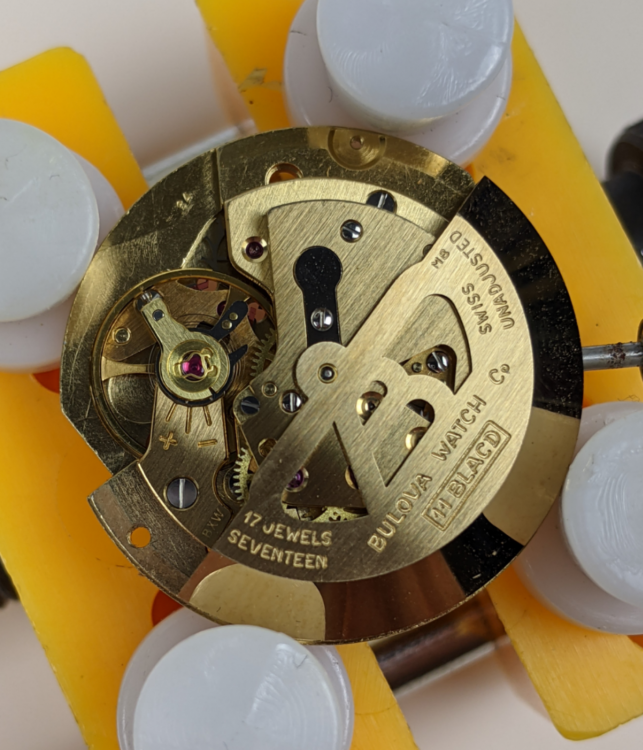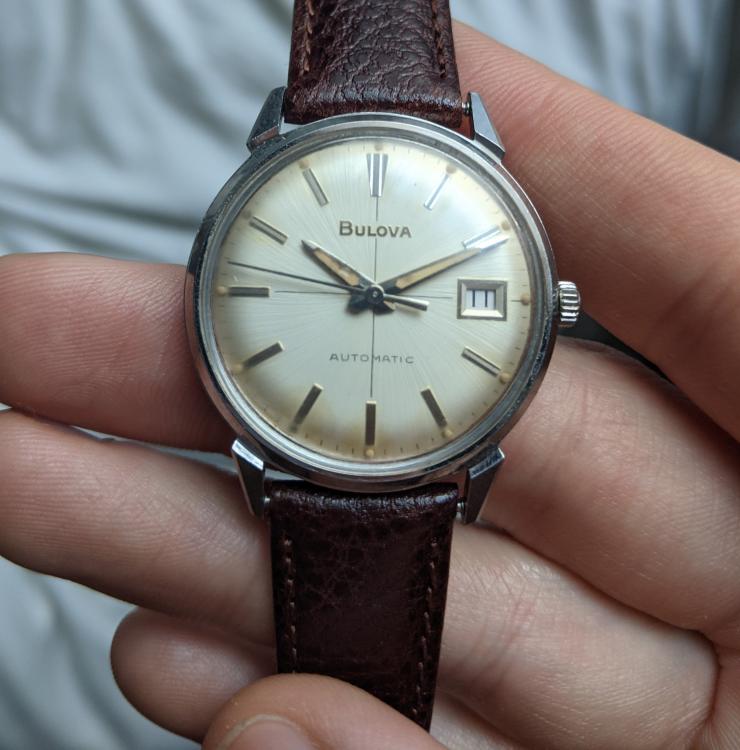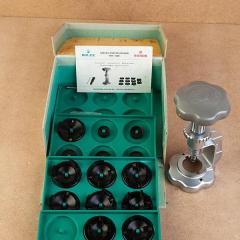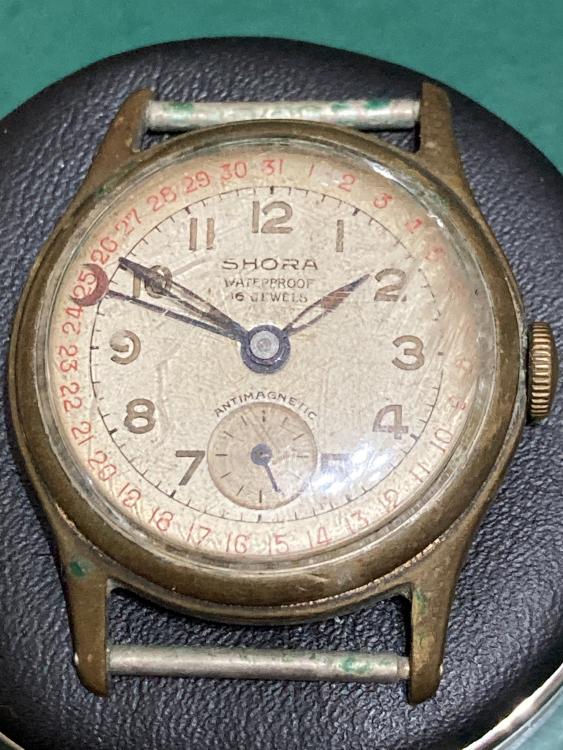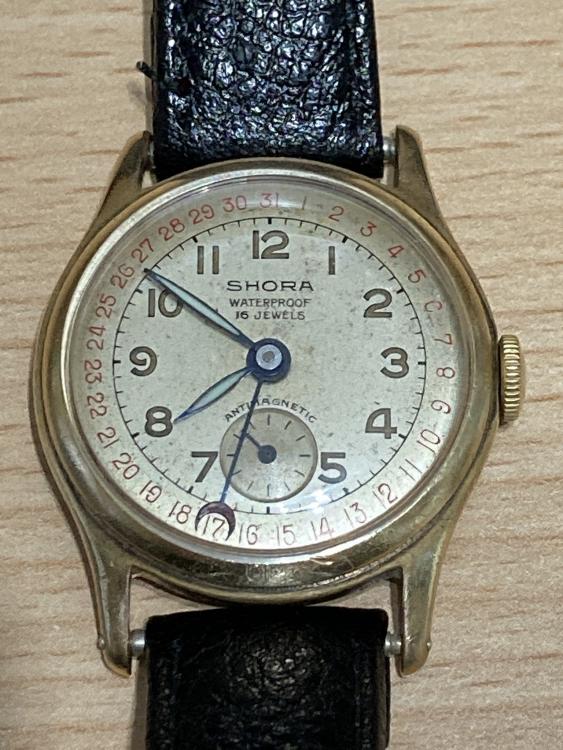Leaderboard
Popular Content
Showing content with the highest reputation on 12/10/20 in Posts
-
It's pretty simple, you take out a balance screw, insert the thread into the hole, then turn it with a screwdriver to remove a bit of metal from the underside of the head. Well, simple as long as you don't break the screw unscrewing/ screwing it, don't lose it, and don't take off too much weight, hahaha. This one has two cutters but they are double ended, they can be flipped around giving 4 sizes of cutter.2 points
-
Hi The gathering pallet can be firmed up with a light tap using a hollow punch, the shaft should be tapered, Just enough to stop it moving as it carries no weight just steps the rack back up to the starting point.2 points
-
Buying from eBay IMO is not a lucrative as it used to be. No real bargains anymore with clock and watch prices way above their value. My cheeky bids never seem to be successful. I suspect it has happened since the introduction of bidding software. Also I have noticed used tools often sell for more than purchasing new2 points
-
Finished my dual balance tack today. Made from brass, the first intent was to allow the balance to rest on the tack to reduce stretching of the hairspring and to provide a tool that would stabilize the balance for work, such as adjusting the beat error. The second reason was to have an additional tack that could be used for smaller pocket watches and watches. I made a quick video to show the process of building this tool. Missed the band saw cutting, but that is obvious. Always use cutting oil. Enjoy. https://youtu.be/nhhGzgypWPk1 point
-
I'll admit, I'm watching too much YT, and doing too little. There are great talents, and very well equipped, that we all know. But what impresses me more is the likes of this:1 point
-
There is a lot of difference between one manufacturer's x10 and another's. Same goes for any other magnification. In my experience, the whole thing is a bit of a minefield. You buy a handful of different magnifications, and discard the ones which are no use for one reason or another, then guard the good ones with your life, whatever x-factor is written on the box.1 point
-
I have used these for years, x10 to start and x25 to finish teh pivots. Cheap and effective. I also remove one side for work where i am no afraid of scards of metal from the lathe. Check out my lathe videos.1 point
-
Modern alloy springs really don't weaken with age. They might develop wear marks which could increase friction as it uncoils, but its modulus of elasticity doesn't change. What can happen with steel springs is they can experience plastic deformation, "take a set", where the coil shape when out of the barrel is clearly smaller than when new. This will reduce its power somewhat, but actually isn't the huge problem many think. The main reason many watchmakers change the spring each service is to avoid broken springs, and for many calibers they are readily available and it's a simple thing to change and eliminate that potential problem (for many calibers they might change the whole barrel). But, I do quite a bit of work for a big, old brand, on their vintage pieces, and 9/10 we don't change the spring This is their decision, and these jobs are often quoted at 10, 20, 30 hours- so the cost of a mainspring isn't a concern when dealing with those kinds of repair prices. Often the watch clearly has its original spring, and I'm talking about 40-70 year old watches.. I think in 6 years we've had one watch come back for a broken spring. I also do work for a shop that sees a lot of vintage chronographs and other really nice pieces, with him also we change the spring when it's necessary, but not as a matter of course except newer stuff like ETA current calibers.1 point
-
Welcome here. If the stem does stay in place either the keyless work is damaged, or the stem has been extracted from the wrong position, as can happen with the ETA 2824 and others. So when it happens you will need to post more details to answer this question.1 point
-
1 point
-
It could be just dried out oil and pocket lint keeping it from going. Or it could have several cracked jewels, the escapement completely out of adjustment (common on American watches, as they had easy to adjust bankings so that's what everyone tweaks when it doesn't run right), it could have worn or bent pivots, particularly on the balance staff, and probably a half dozen other things wrong with it. If you don't have any or much experience working on watches, set this one aside and find a more modern, large, Swiss movement, that's not automatic and without a date mechanism. While it's possible that it's a simple repair, and you wouldn't be the first to dive in with such a watch, it's much better to get some experience and confidence with simpler pieces which have likely seen much less abuse in their lifetime. The old American stuff can be quite a headache, with several different versions of pivot and jewel sizes, different mainsprings, for the same base caliber. Add to that they have probably been serviced a dozen times or more in the past (it was common to have your watch serviced every year at that time), and not always sympathetically, it's a potential can of worms. If you are really set on getting into it post some pics and ask many questions!1 point
-
That's a balance screw undercutter, used to remove weight from balance screws when poising. This one is probably for a limited range of pocket watch sizes; there are tools with 6 or more cutters to accommodate a larger range of screw sizes.1 point
-
Hello! I've always been interested in mechanical watches but always thought it would be too complicated for me to learn. After reading some books and watching a lot of youtube I'm happy to say that I've begun to find success in restoring vintage watches! So far my proudest achievement has been a full servicing of an automatic Bulova 11 BLACD movement which has been running smoothly for months! I've got a lot to learn and I'm excited to get some advice for issues that have been stumping me.1 point
-
1 point
-
Just pulled the trigger on one of these "beasts" from the US expected to arrive in Europe, Sweden sometime between Dec 25 and Jan 02. I'll update this thread once I've tested it. Should I forget, and you're interested, please remind me!1 point
-
1 point
-
Precision timekeeping is an interesting term of just basically meaning the watch keeps good time. But unfortunately there is a little more that needs to be done than moving the regulator and worrying about the poise of the balance wheel. I Have some PDF examples. As you're aware companies like ETA have their technical service bulletins but they also have had what they call manufacturing information. I always find these quite fast Fascinating because it has all the technical stuff usually missing off the other one. If you open up both PDFs and you scroll down you'll find that both grades, and multiple of qualities basically. Like for instance the 7750 as three of them labeled Elaboré, Top And Chronomètre. Then the 6497 only has two different ones. So if you look at the less you'll notice that in the case the 6497 there basically almost identical other than me get to the bottom they've regulated one of them better and they time it in one more position. On the 7750 you'll notice that there's a lot of differences besides the timekeeping. They're using better and better materials. Then of course are timing and more and more positions or verifying basically that they keep time in those positions. What becomes interesting when you look at these is for instance the 6497 can be regulated to keep better time. But if you notice it's timekeeping versus the 7750 it will keep better time because it's materials that they used are better. The simplistic of this is better timekeeping requires better everything. A jeweled lever escapement versus a pin lever escapement is an improvement. All the materials related to the balance wheel. Then just the time and effort made to adjust things is going to be better than a watch that was made to be inexpensive. You can still spend some time making it better but there's a limit of what you're going to do. ETA 6497-1 Manufacturing Information.pdf ETA 7750 MANUFACTURING INFORMATION.pdf1 point
-
Have you seen THESE? Not cheap but I think you can run more than one clock off of them.....1 point
-
The surest way to minimise the risk that your new acquisition doesn't need servicing straight away is to buy brand new. This is pretty well the case, particularly with the low prices that eBay can end up yielding for the less exotic end of the range. If you buy from a reputable dealer and get some kind of a warranty then you have some recourse if the watch isn't as described, but that's not so easy with eBay. The problem with the eBay is one of credibility. Anyone can say that the watch that they are selling is "recently serviced", which is a really ambiguous statement. Does "recently" mean in the last 6 days? 6 months? 6 years? And by "serviced" do they mean a quick buffing of the case and crystal and new gaskets? or are we talking about a full strip down of the movement, proper component level cleaning, inspection, adjustment or replacement, re-lube, regulate, etc... If I sell a watch on eBay it will almost certainly be serviced and stated as such but this has nothing to do with trying to get a higher price to recoup the cost of servicing. The reason that I buy a watch in the first place is usually because it isn't running and I want to fix it, which invariably requires a full service as described above. I do this myself so the costs are limited to any replacement parts. I photograph the process and post a walk through on a blog for the world to see, and when I state in an eBay listing that the watch has been serviced I post a link to my blog so that potential buyers can see what work I have done. The improvement in the selling price usually only just covers the cost of the replacement parts compared to selling in the same cosmetic condition without any claims of servicing. Sad but true. Where I do get a benefit is that quite often the buyers will be people with a collection of moderate value watches which are in need of servicing but they can't justify the cost of "professional" servicing. If the watch that they buy from me provides them with sufficient confidence then I may get approached for servicing work on the other watches in their collection. If you want to build a collection of modest value mid-century pieces that you can be confident are in good running condition without incurring unrecoverable costs your best bet is to either do the servicing yourself, or to find someone who will do the work for you at a price you are happy with. Welcome to the best place on the WWW to learn how to go about doing it yourself ?1 point
-
Hello, Welcome to WRT. Interesting question, and here’s how I acquire my watches but with a different kind of objective/acceptance in mind. I too am attracted to vintage watches anywhere from the 1920’s up to the 1960’s. also some of the ornate silver pocket watches up to the 1920’s. Ebay has always been my first port of call, generally for the vastness of timepieces available and sometimes some real bargains to be had. However, unless a watch is claimed to have had a service, I’ll always accept that it’s likely to need one, and for me, I actually get a kick out of buying some of the tattiest looking watches (with a vision of their potential) and restoring them back to glory. These have been some of the cheapest to buy and highest price returned when selling on (but not always). Btw, I’m self taught with the help of Mark’s videos and the wonderful experts on this forum. I guess in answer to your specific question, you’d be looking for those advertised as keeping excellent time and either a mention of a service in the past 2-3 years or evidence of (as you’ve already mentioned), a healthy amplitude on the timegrapher (rare advert content but sometimes there). Realistically though, unless I had proof of a service I’d assume they need one. You may also stumble upon the likes of sellers like me who are hobbyists and whose main satisfaction is from restoring/servicing watches and then selling on for a price enough to cover the cost of parts and a small reward for their time and cost of consumables. The evidence I give on eBay are photos of the watch in various stages of being serviced and always one of the all disassembled parts in the tray. Therefore, looking for “Serviced” in the search title may well find you what you’re looking for. Modestly priced for me may be different for others! For example, I sometimes buy something for £25, restore/service, and sell on for £75 after replacing the mainspring and fitting a new crystal and strap (even then with attempts from buyers to knock my price down!). These are the watches you mention that would usually be uneconomic to repair (certainly on the High Street). For the record, I’m not trying to promote my watch sales here and neither will I reveal my eBay identity or accept servicing requests ?. I’m merely suggesting that there are serviced watches out there to be had at very reasonable prices in answer to the question. An example of a before/after shot of a recent restoration is shown in the photos (already sold). The watch cost me £23 in its sorry non-working condition!1 point
-
1 point
-
It's when you push a watch to its limits of rating. On something like this, which is a pin lever movement with one jewel, you can't do that much, as it's a piece that's been made to a price point and there just aren't that many things you can retouch. You could probably get it closer than 100s delta, if it's running really well. Like if you are seeing this excellent amplitude in the dial down position, if it's close to the same in dial up, and then the drop in amplitude isn't more than 40 or 50 degrees going to vertical, you might get it better by getting the hairspring spot on and then possibly even doing some poising. But it would be time better spent learning such things on a jeweled watch with lever escapement. Something big and stable like a 6497. In a watch like that you have a real cause and effect, and can see the results of your actions unambiguously. With lower grade movements there are so many compromises already made that you are limited and things might not respond to what would be considered a correct correction on something higher grade. So you might have taken good advice here or from books, apply it to your EB, and nothing or the opposite of what you wanted happens- but you don't know if you did something wrong, or it's just how it is. The simple fact that this probably has a Nivarox grade 5 hairspring would make it hard to adjust (1 is the best, and there is a real difference in performance between the different grades- 5 being the worst).1 point
-
Zodiac 70 72 made by AS was a joint production of some famous brand names, beats 36000 times an hr so is more accuracy (the higher the beat the more accurate the watch) furthure a fine regulator was added on, decent stability so you had a good watch. The only culprit I know is their offset canon pinion, in fact it needed replaced at every service, so is a hard to find and one mostly have to resort to tighening its canon pinion. not exactly how a jewel should be. also 72 mysetry dial gained popularity in its day. On autographic a power reserve indicator was put at center along with sweep second ,min and hour hands which was special if not exclusive. Complications on most pieces had a interesting and unique design. Many complicstion. I have got a hand full zodiacs, but if you ask me, I spend my money on a nice manual Omega.1 point
-
If you're going to start doing precision timing the watch has to be in perfect condition. If a whole bunch of things seem pretty good you'll be chasing your tail. Definitely an out of true hairspring can cause problems. It must be true, in the flat, round, and same at the collet. If that's good, and the escapement is correctly adjusted, regulating pins gapped correctly and spring centered in them, pivots particularly of balance, fork, and escape wheel perfect, and all else is good, you can start hunting what might be a poise problem. If this is a one or 7 jewel watch (thanks Joe), get your hairspring adjusted as well as you can, close the regulating pins (I bet they're wide open), and be happy if it's around 60s delta.1 point
-
EB 8800 came in 1/7/17 jewels versions, which one is your watch? I can't figure out, what in the sam hill where they thinking to make the one jewel variant and claim concern about positional variations too. As for your concern about hairspring material degredation, unfortunate as it might be, it simply sounds like an unchartered territory, 100s/d doesn't sound like a fouling hairspring either. Good luck pal.1 point
-
@Poljot Yes it worked, I was able to take out the bezel and crystal attached with it . After that it was super easy. Thanks a lot for advice, really appreciate it1 point
-
Isn't it a notch? In this case you may need something like Bergeon 4932, or SWISS army knife ?1 point
-
Shove it in! If it’s very firm then try a vice with suitable protection. Occasionally I use a crown on the end of the tube to help. Also, a soft hammer such as a timber mallet can work well, but avoid distorting the end of the pendant tube.1 point
-
Yes, there will occasionally be a corresponding mark on the barrel edge. If not, then there may be an additional mark on the barrel cap. But it’s not the original reason for the cutout, obviously.1 point
-
as usual problems in the horological discussions can occur like here. Whacking with a hammer seems a bit harsh like very bad things would occur except it's how I take my lids off the barrels of the watches that I work on. There typically American pocket watch lids. I've try because there's a notch and I know what the notch is for I've tried I usually can't get the screwdriver underneath I usually scratch the edge of the barrel and usually the lid does not come. Somewhere in my life somebody showed me somewhere whacking with a hammer works really well. Okay everyone take a deep breath the world did not come to the end because I whacked with a hammer. As far as I can tell I've never had distortion of the lid because these are like small clocks in a way they're very thick and it's a very sudden fast impact. If it's something modern I usually put it in the palm of my hand use the backside of the tweezers and just push the arbor and pop the lid off. That method corresponds sort of like the image I attached of how the Swiss perceive you should remove the modern lid. Then they also recommend putting it back together without the mainspring and verifying that the lid is flat and not distorted.1 point
-
typically they're not supposed to run fast if they run fast somebody didn't phase the watch correctly. Or they didn't phase the watch taking into account that there now using a silver cell with a higher voltage. perhaps today this is true because were all familiar with quartz watches. At the time in the tuning fork watch came out Bulova discovered the watchmakers were having issues. So they had a several day training program. Unlike the training programs or stuff the other watch companies were doing where you got a certificate just to be there this was different. Two days of intense training with a written and practical exam. Only those people that passed got the certificate and could call themselves a Certified Accutron Technician. as this is an electric watch the same test equipment you have for quartz watches will work fine. Variable voltage power supply with the ability to measure microamps. Unlike quartz watch repair a microscope is necessary to do the phasing. The index wheel and the jewels associated are really tiny and a microscope would be rather nice here. to get you started I have some light reading. The 214 service manual is really where it all get started so it explains about how it works phasing etc. Then there's a fact book that explains similar stuff. then the Omega tuning fork in this discussion wasn't really made by Omega. The Swiss needing their own tuning fork watch designed a new tuning fork watch and it was sold by a whole bunch a Swiss companies. I have the manual for that and this is interesting watch as it implemented all sorts of improvements to make it much easier to work on. then an interesting link. Notice they have a reference to how to phase the tuning fork watch to run at a higher voltage. These watches were designed specifically to run with Mercury batteries and were never meant to run on silver cells with the higher voltage. This requires a slightly different procedure for phasing which is why you require a variable voltage power supply. http://members.iinet.net.au/~fotoplot/acc.htm Accutron 214 ServiceManual.pdf Accutron Facts Booklet.pdf ESA 9162 Repair Manual Omega 1250.pdf1 point
-
https://www.cousinsuk.com/category/hands-watch Probably this link gives you even more info. You can also download Parts List for your movement, if it is available using the same website, but "document search" page: https://www.cousinsuk.com/document1 point






